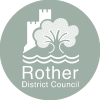Version 4.3
Contents
- Introduction
- Street Naming
- Property Numbering
- Property Naming
- Address Changes
- Contact Information
- Appeals and Complaints
- Glossary
- Appendices
1. Introduction
The address of a property is an important issue; The Emergency Services, including the Police, Fire and Ambulance Services, and the public need an effective way of locating and referencing properties.
The naming and numbering of streets and buildings in Rother District is controlled by Rother District Council (RDC) under The Public Health Act 1925, Sections 17 – 19. This makes RDC the Addressing Authority for the district. No other body has addressing powers.
This Policy guides RDC in exercising its responsibilities for:
- Street naming
- Property numbering
- Address changes
The remit for this role rests with the Street Name and Numbering (SNN) Officer who has delegated authority to make decisions and implement this policy on behalf of RDC.
The process of street naming usually occurs after planning permission has been approved for developments which involves the creation of a new road(s) and the erection of a new building(s) which require a postal address.
Developers, residents, and customers wishing to change the name of their property or seeking an address for a new property need to apply online following the procedures detailed in this policy. The same applies to those who wish to confirm the street numbering of properties within Rother District.
RDC will ensure that everyone receives the same level of service, based solely on relevant factors and taking individual needs into account. All Council Officers and customers must be treated with courtesy and respect.
The decisions made under previous versions of this policy do not set precedents for new decisions which will be governed by this policy.
The Council will decide on any circumstance not explicitly covered by this policy based on industry standard definitions and norms, and widely accepted best practice for Local Authority Street Name and Numbering.
2. Street Naming
2.1 Street Naming Procedures for New Developments
Developers are encouraged to propose their own street names for new developments along with the reasons for choosing those names. Proposed street names must adhere to the criteria outlined below.
Developers should start the street naming process soon after planning permission is granted by consulting the SNN Officer, who will decide on the number of streets which will be created by the Development. The process should be started no later than when Building Regulations are sought, or an Approved Inspector Notice is issued.
Developers must also consult with the relevant Parish or Town Council (PTC) on any proposed street names and will be required to provide evidence that the views of the relevant PTC have been sought. If a PTC does not respond within one month of their views first being sought, then the street naming process will continue without their involvement. See Appendix C for guidance to PTCs and developers on street naming consultations.
Developers should include at least one additional street name when proposing a new street name in case the preferred name is not considered to comply with this policy.
Developers must not use a proposed street name for marketing purposes if it has not been formally approved by RDC. Furthermore, developers must not give any postal addresses, including postcode, to potential occupiers, either directly or indirectly (for example via solicitors or estate agents) before formal approval has been issued by RDC.
Where there are no objections to a proposed name, or after agreement has been reached, the official street names will be confirmed in writing by RDC.
Please note that the final decision on street names resides with the SNN Officer and may not include any of the developers’ or PTC’s proposals.
Developers are encouraged to use the final approved street name as part of their advertising and public communications as it can be helpful for the legal process and the Emergency Services.
Royal Mail is responsible for the allocation of postcodes. It will allocate a postcode only to those streets that have properties on them that require the delivery of mail and only after confirmation from RDC of an official address.
RDC reserves the right to change a street name at any time, should it be discovered that the street name is in breach of this policy.
2.2 Street Naming Criteria
Proposals for new street names or for converting an access road or driveway into a named street should, in most cases, be restricted to roads that serve three or more properties.
Where possible, a street name should have a proven historical connection to the land intended for development. Encouragement and preference are given to names that reflect local natural history or the nature of the local terrain.
Proposals for street names that relate to a commercial reference, or a name that could be construed as used for advertising or commercial gain, will not be permitted.
Proposals relating to a person’s name will only be permitted for commemorative purposes and only for significant historical figures.
Street names must not be offensive, or have the potential to cause offence, as defined in the Equality Act (EA) 2010. Street names that could be easily vandalised or changed into something which could cause offence, including their combination with numbers, will not be approved.
New street names must not duplicate or be similar to any name already in use within the district or near to the Rother District boundary in a neighbouring authority. This will fall under the discretion of the SNN Officer.
Street names must not be difficult to pronounce or awkward to spell and must not be phonetically similar to another street (e.g., Woodgate Road and Woodsgate Road) within the same town or village.
The use of North, South, East, or West (as in Collington Lane East) is not encouraged and is only acceptable where the road is continuous and passes over a major junction. It is not acceptable when the road is in two separate parts with no vehicle access between the two.
Street names must not begin with ‘The’.
The street name suffix (Close, Avenue, etc.) must be on the approved suffix list and must accurately reflect the type of street, as described in Appendix A.
Non-vehicular pedestrian ways must end with either Path, Way or Walk.
2.3 Erection of Street Name Plates
The official naming and numbering scheme for the development will be sent to the applicant as part of the official notification.
It is unlawful to erect a street name plate before the street name has been formally approved and confirmed in writing by RDC. Contravention currently attracts a fine of £200 under the provisions of the Criminal Justice Act 1982 (Chapter 48, Section 37, Standard Scale Level 1 Offences). The level of the fine will change in accordance with any revisions to the Act.
Once approved, street name plates must be placed in a location that is clearly visible from the street.
All costs for the erection of signs for new streets will be borne by the developer. Specifications for the signs and their locations is available on the Street Name Plates page of the Council’s website. The maintenance of street signs becomes RDC’s responsibility only if, and when, a street has been adopted. In this case, it is the Estates team that is responsible for Street Name Plates within RDC.
2.4 Street/Highway Adoption
Adoption of a highway is a matter for the Highway Authority which, in Rother District, is East Sussex County Council.
3. Property Numbering
3.1 Property Numbering Procedures for New Developments
The process of property numbering within a street will not start until planning permission has been granted for the development and developers should contact RDC as soon as possible after approval.
Developers must provide an electronic site layout plan, as well as an internal layout for plan for any communal buildings, at no less than 1:500 scale. The plan should clearly indicate the plot numbers and location of each separate dwelling, office or business unit, with the main entrance points to the buildings indicated by pathways.
It should be noted that the allocation of an official address does not serve as confirmation that any building or structure has been authorised under Planning, Building Regulations or any other Legislation. Owners/occupiers may be at risk of enforcement action if any necessary approvals have not been obtained.
A charge is applied for property registration and numbering. An additional charge will be made where changes are requested to an approved scheme during development. Charges will not be refunded where an application does not have the correct planning permission. Current fees are listed here: www.rother.gov.uk/SNN.
3.2 Property Numbering Policy
RDC complies with BS7666 (2006) – Spatial Data Sets for Geographical Referencing. Developers are encouraged to liaise with RDC at an early stage to ensure that property number requirements comply with BS7666.
An official address will not be granted without the relevant planning permission(s) being granted. An address can be withdrawn if it is established that there is not an approved planning permission in place to support the creation of that address.
All new streets must have a numbering scheme and a proper sequential numbering sequence shall be maintained in all cases (no omissions considered).
It is important to ensure the numbering sequence of any street is not disrupted when additional properties or developments are built. Where such development is small scale, this might involve each new unit being given the number of the old property plus a letter suffix. Large-scale redevelopment might include a new access road giving the Council the opportunity to introduce both a new street and numbering scheme.
In towns (i.e., Bexhill, Battle and Rye) new streets will be numbered so that, when travelling away from the centre of the town, the odd numbers are on the left-hand side and even numbers on the right.
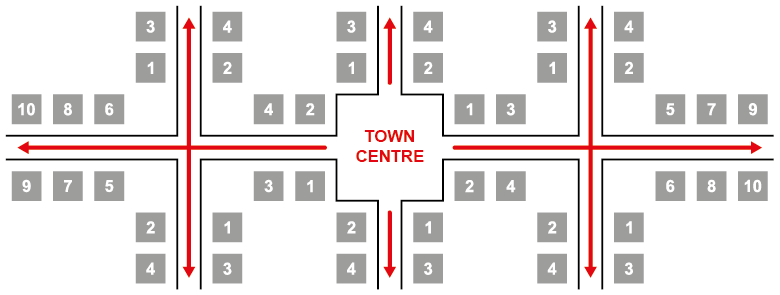
Exceptions to this include cul-de-sacs, where properties will be numbered consecutively in a clockwise direction, and streets with properties only on one side, where properties will be numbered consecutively.
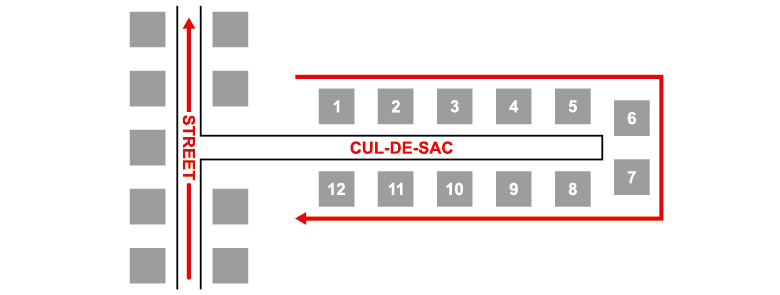
In villages and other areas, the SNN Officer will assign property numbers as appropriate.
All flats with a common entrance should be numbered in a clockwise direction from the primary point of entrance to each floor.
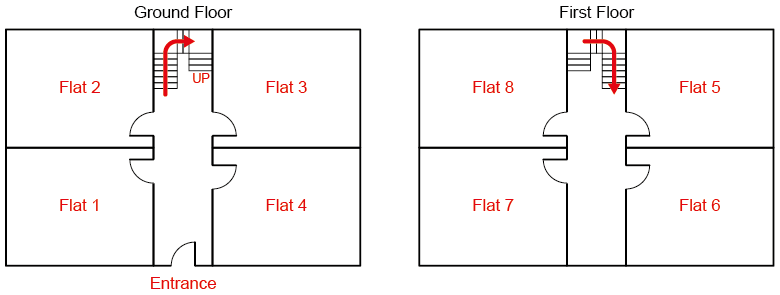
Where a floor can be accessed from stairs and a lift, the primary point of entrance to the floor will be the stairs. In a case where a floor can be accessed from two sets of stairs, the primary point of entrance to the floor will be the first set of stairs that is arrived at from the primary entrance on the floor below.
In situations where one of the flats in a building has its own, separate, entrance, and is not accessed via the common entrance to the building, then it shall take the number of the main building and be suffixed with a letter, starting at A.
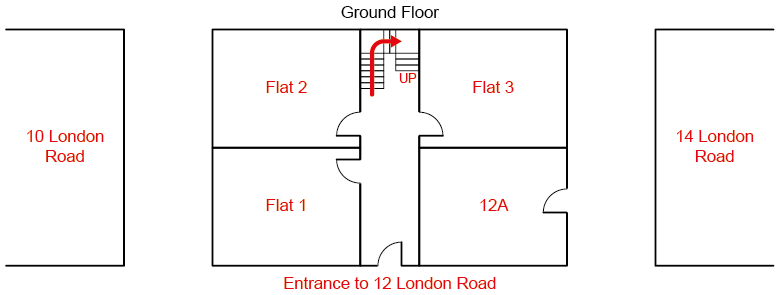
Private garages and similar buildings used for housing cars and similar are not numbered.
Buildings (including those on corner sites) are numbered according to the street in which the main entrance by foot is located.
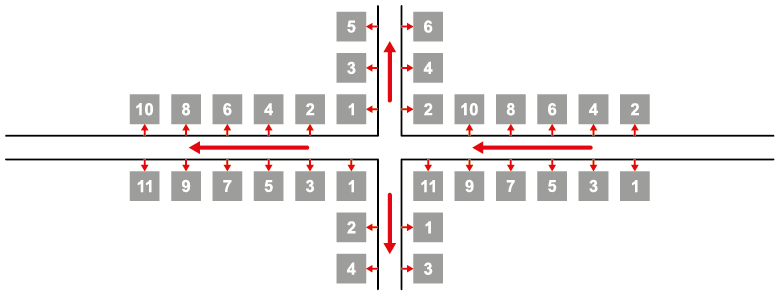
Where multi-occupied buildings have entrances in more than one street, then the location of each entrance will dictate both the numbering and address of the units served from that entrance.
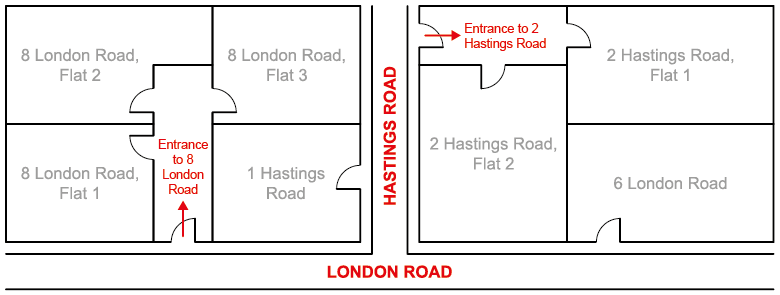
All properties must prominently display the relevant number, or house name where there is no numbering scheme, so that it can be easily seen by visitors and the Emergency Services from the street.
Once properties are numbered, the Council will not usually renumber them unless the SNN Officer deems it to be necessary.
The Council reserves the right to renumber a property, at any time, should it be discovered that a number has been approved in breach of this policy.
4. Property Naming
N.B. Where the ‘Owner’ of the property is referenced, this refers to the Freeholder only and not the Leaseholder, Tenant, or other occupier.
4.1 Property Names
A new name can be added to an existing postal address, but the postal number cannot be deleted from that address. The property number must still be displayed and referred to in any correspondence. Proposed property names must adhere to the criteria outlined in Section 4.2 below.
Certain streets exist that do not have a numbering scheme. In these cases, where a new building is built in the street, a house name should be nominated and approved by the SNN Officer before first occupation. The allocated name forms part of the official address and should be prominently displayed.
Only owners of properties may change an official name. They should apply to RDC providing all the necessary information as requested in the online form available on the Council’s website . In the case of joint ownership, all parties must agree to the proposed change.
A property name will not be formally changed where the property is in the process of being purchased. Only when a purchase is complete can a name change request be accepted.
A non-refundable fee, payable on application, will be made for changing a property name. There will be an additional charge for each sub property (for example, a detached annexe or the individual flats within a building) that will need to be changed because of the parent property name being changed. Current fees are listed here: www.rother.gov.uk/SNN.
RDC reserves the right to change a property name, at any time, should it be discovered that a name has been approved in breach of this policy.
4.2 Property Naming Criteria
Property names that have a historical connection are preferred. Encouragement is also given to names that reflect local history or the nature of terrain.
Proposals for residential properties that relate to a commercial reference, or a name that could be construed as used for advertising or commercial gain, will not be permitted.
Proposals relating to a person’s name will only be permitted for commemorative purposes and only for significant historical figures.
Property names must not be offensive, or have the potential to cause offence, as defined in the Equality Act (EA) 2010. Property names that could be easily vandalised or changed into something which could cause offence, including their combination with numbers, will not be approved.
New property names must not duplicate or be similar to any name already in use within the town or village or in the same postcode area (e.g., TN40). A variation in the suffix, for example, ‘hill’, ‘house’, ‘cottage’, etc., would not constitute sufficient change. This will fall under the discretion of the SNN Officer.
Property names must not be difficult to pronounce or awkward to spell and must not be phonetically similar to another property (e.g., Beach Cottage and Beech Cottage) within the same town or village.
Property names must not begin with ‘The’.
5. Address Changes
N.B. Where the ‘Owner’ of the property is referenced, this refers to the Freeholder only and not the Leaseholder, Tenant, or other occupier.
5.1 Renaming of Streets / Renumbering of Properties
Proposals for new street names, or for converting an access road or driveway into a named street, must have the written agreement of all freehold owners.
RDC will only rename a street in exceptional circumstances, such as when it is known that the name causes confusion for statutory service providers, the Emergency Services or collectively for local residents.
Furthermore, RDC will only recognise an alteration to an existing street naming/numbering scheme where the proposed alteration is in the wider public interest and improves or eradicates confusion. RDC has authority to issue Renaming or Renumbering Orders if any anomaly becomes evident.
RDC will consider renumbering a property, at the discretion of the SNN Officer, in the following situations:
- where there are documented habitual delivery problems;
- where infilling or subdivision of the property has occurred;
- where the safety of delivery drivers is of concern;
- where access has changed from one street to another; or
- any other situation deemed necessary by the SNN Officer.
If an existing street is renamed or renumbered, the relevant PTC will notify affected property owner/occupiers via consultation.
When address corrections are made, it is, in most instances, the owner’s responsibility to inform their tenants/occupiers, however, RDC will generally request this of the owner during the process.
6. Contact Information
Street Naming and Numbering Department: www.rother.gov.uk/SNN
Street Naming and Numbering
Rother District Council
Town Hall
London Road
Bexhill
East Sussex
TN39 3JX
Street Naming and Numbering services:
- Registration of New Addresses
- Confirmation of Official Address
- Naming and Renaming of Existing Properties
Planning Development Administration: www.rother.gov.uk/planning-and-building-control/
Contact information and Street Sign Specifications: www.rother.gov.uk/article/1467/street-name-plates
7. Appeals and Complaints
If you wish to contest a decision made by the SNN Officer then, in the first instance, please email us directly at: rothersnn@rother.gov.uk.
If we are still unable to come to a resolution, then you can appeal in writing, via online form or by post.
- Online Form: www.rother.gov.uk/complaints
- Post: Complaints, Rother District Council, Town Hall, London Road, Bexhill, East Sussex, TN39 3JX.
When requesting a review of the decision via appeal, you must include all supporting evidence.
While RDC will constructively engage with developers and customers regarding all aspects of this policy, RDC reserves the right to make a final decision on all proposals subject only to successful legal challenges made to the local magistrates court.
A review of the decision will consider if an application has been handled in an appropriate and courteous manner but will not necessarily change the outcome of any decisions.
For more information about the customer complaints process, please visit www.rother.gov.uk/complaints.
8. Glossary
| Term | Description |
|---|---|
| BS766 (2006) | British Standard Spatial datasets for geographical referencing. |
| BLPU | Basic Land and Property Unit – an area of land, property or structure having uniform occupation, ownership or function. Such a Unit attracts a UPRN (see below). |
| Developer | The person or organisation engaging with the Council for the purpose of Street Naming and/or Property Numbering. |
| GeoPlace | Formerly, The National Land and Property Gazetteer – The National Data Set, now known as AddressBase, which contains unique reference (UPRN), geo codes point and address information for all property and land within England and Wales. |
| Locality | Another local description added to the address which is not held in the official address. |
| LLPG | Local Land and Property Gazetteer – Contains the official address data for all properties (Houses, Flats, commercial premises, etc.) and non-addressable objects (Bin Stores, Recycling locations, Cricket Pitches, etc.). |
| LLPG Custodian | Council Officer responsible for maintaining the LLPG address dataset for Rother District Council. The LLPG Custodian also holds the role of Street Naming and Numbering Officer. |
| Owner | Where the ‘Owner’ of the property is referenced, this refers to the Freeholder only and not the Leaseholder, Tenant, or other occupier. |
| Property Naming | A request for a house to be named or to change its name. |
| Property Numbering | The allocation of numbers and suffixes to properties. This may include houses, flats, industrial units, and groups of static caravans. |
| Property Number Suffix | A letter that is added to a number usually to describe a dwelling or commercial property that has more than one internal unit. For example, where an extra property is built between 22 and 23 High Street would be called 22A High Street. |
| PTC | Parish and Town Council |
| RDC | Rother District Council |
| Street | The generic name for a road, street, pathway, thoroughfare alley, lane etc. The street naming function is administrated by the Local Land and Property Gazetteer Team of Rother District Council. The designation of the class of Road, e.g. A1, A27, B2121, is administered by East Sussex Council. |
| Street Name and Numbering (SNN) Officer | Responsible for the statutory duty of Street Name and Numbering for the district. This role is currently held by the LLPG Custodian. Authority for this role is delegated by the elected members of the council (Councillors). |
| Street Naming | The allocation of or change to the name of a ‘Street’ as defined above. |
| Street Name Suffix | This is the second part of a street name, for example Road, Street or Place, etc. |
| Street Renaming | Changing the name of an existing street. |
| UPRN | Unique Property Reference Number. Each BLPU has a reference number or UPRN. Each UPRN has a maximum of 12 digits, is unique within the UK and has no internal structure related to the geographical location of the BLPU to which it relates. The maintenance of uniqueness is carried out by GeoPlace. All properties, both residential and commercial, now require a Unique Property Reference Number (UPRN), and it is required in most dealings with the Land Registry. The allocation of a UPRN includes separate flats and distinct units within commercial properties. An historical trail will be built up in relation to each UPRN within the AddressBase products. The Street Naming and Numbering Unit of Rother District Council will populate its software with all UPRNs and make these available to all relevant customers. |
9. Appendices
Appendix A – Street Name Suffixes
TR: Can be assigned to a Through Road, NTR: Can be assigned to a No-Through Road
| Suffix | Description | Type |
|---|---|---|
| Approach | Any road leading to a notable building or location | TR/NTR |
| Ascent | Hillside road only | TR/NTR |
| Avenue | Any residential street bounded by trees | TR |
| Circus | Any large roundabout | |
| Close | Any cul-de-sac only | NTR |
| Crescent | Any crescent shaped street | TR/NTR |
| Croft | Any cul-de-sac leading to a croft or small farm | NTR |
| Drive | Any residential road | TR/NTR |
| Field | Any cul-de-sac within a development that was previously a field | NTR |
| Gardens | Any residential road with links to gardens | TR/NTR |
| Green | Any residential road with links to village greens or public green spaces | TR/NTR |
| Grove | Any residential road in a small wood or group of trees | TR/NTR |
| Hill | Hillside road only | TR/NTR |
| Lane | Any narrow rural thoroughfare | TR/NTR |
| Mews | Any short road which leads to a stable yard or horse related site, or a short row of terraced houses built to look like converted stables, or terraced houses surrounding a courtyard | NTR |
| Place | Any short road or access way | TR/NTR |
| Rise | Hillside road only | TR/NTR |
| Road | Any thoroughfare | TR/NTR |
| Row | Terrace of properties (but not a subset of named street) | TR/NTR |
| Straight | Any straight and narrow urban thoroughfare | TR/NTR |
| Street | Any thoroughfare (generally used for urban roads) | TR/NTR |
| Terrace | Terrace of buildings (but not a subset of named street) | TR/NTR |
| Twitten | Any narrow urban thoroughfare | TR/NTR |
| View | Any road that has a notable view or panorama | TR/NTR |
| Walk | Any short road which leads to a courtyard or small terrace of houses | NTR |
| Way | Any thoroughfare (generally used for main roads) | TR |
| Wharf | Any quay side road where shipping was docked and unloaded | TR/NTR |
Appendix B – Local Land and Property Gazetteer (LLPG) Information
All changes made through the street naming and numbering process and through notified name changes are included on the Council’s Local Land and Property Gazetteer (LLPG), which is used in the delivery of the Council’s services.
Our local gazetteer together with the gazetteers of other local authorities are in turn linked and updated daily to a definitive index of land and property in England and Wales known as the National Land and Property Gazetteer (NLPG).
The Council’s Local Land and Property Gazetteer Custodian informs not only our internal Services of changes, but also updates external contacts. Owners remain responsible for informing utilities and all others not detailed below.
Agencies and Authorities who are informed of Street and Property Changes:
- GeoPlace – by Data Transfer Protocol File
- East Sussex County Council – Transport and Environment
- Sussex Police
- East Sussex Fire and Rescue Service
- District Valuer & Valuation Officer (VOA)
- Royal Mail
- All Departments within Rother District Council
It should be noted that GeoPlace’ AddressBase products are the national method for informing all authorities and agencies of changes. Many statutory agencies, such as Fire & Emergency Services, now get information directly from GeoPlace.
Appendix C – Advice and Guidance to Parish and Town Councils and Developers on Street Naming Consultations
As discussed in Section 2.1 of the SNN Policy above, Rother District Council (RDC) is keen to consider the views of Parish and Town Councils (PTCs) on proposals involving the naming of streets.
It is important to note that this is a consultation exercise to gather suggestions for street names and, while RDC will consider the views of both developers and PTCs, the final decision will be made by the RDC SNN Officer who may decide to include all, some, or none of the submitted names.
A full list of the street naming criteria can be viewed in Section 2.2 of the SNN Policy above, however the following criteria are reiterated. Street names must not:
- have a commercial reference.
- duplicate a similar name or similar sounding name within Rother District, or near to the Rother District boundary within an adjacent authority.
- relate to a living or recently deceased person.
- cause offence or have the potential to cause offence.
Developers are encouraged to use the FindMyStreet service to check for similar or duplicate names before submitting any proposed street names to either RDC or the PTC.
Notes for Parish and Town Councils
The PTC will need to establish a process for reviewing and responding to street naming submissions from developers. The PTC could choose a process that:
- includes a consultation with residents, either at a Council meeting, or through feedback via their website. Or,
- is undertaken by a committee, either through an in-person live meeting, video conferencing, or by exchange of correspondence between members (emails, chat forum, etc.). Or,
- grants the responsibility for street naming responses to a nominated Councillor. Or,
- meets the required objective of consideration and response by an alternative means to those listed above.
The process must include:
- a reply from the Clerk to the developer within 5 working days to acknowledge receipt of the submission. The reply must include an expected response date to the developers’ proposals.
- a full response to the proposals must be sent from the Clerk to the developer within 1 calendar month.
All names submitted to the PTC by the developer must be considered and responded to. As part of the response to the developer, any names that are not supported by the PTC should be accompanied by the reasoning behind it. This is also an opportunity for the PTC to make alternative suggestions for the developer to consider, including an order of preference for the submitted names, if required.
Notes for developers
The developer will provide the Clerk at the PTC with:
a list of suggested street names, including suffixes.
a site plan containing the location and layout of the streets to be named.
It is recommended that the number of names provided to the PTC is greater than the number of streets to be named to allow for any that may be ineligible or undesirable. Available suffixes and their permitted uses can be found in Appendix A above.
Once the developer has received a response from the PTC, they can review the feedback and decide if they wish to amend their proposal.
Once the proposal has been finalised, the developer will forward their submission together with the PTC correspondence to the RDC SNN Officer (rothersnn@rother.gov.uk).
Notes for both parties
It is hoped that a street naming agreement between the developer and PTC can be reached and that any differences can be resolved through amicable dialogue.
While a proposal supported by both parties is preferred, it is not essential as the final decision on street naming will be made by the RDC SNN Officer. This will be based on the submissions from both the developer and the PTC, as well as the eligibility criteria listed in Section 2.2 of the SNN Policy above.
Both the developer and the PTC will be advised of the decision, together with any reasoning if needed, and they will have an opportunity to respond.
If the decision is accepted by both parties, then the process of officially naming the street(s) will commence.
If either party feel that that RDC have not followed the process outlined in this Policy correctly, they may appeal the decision as described in Section 7 above.
